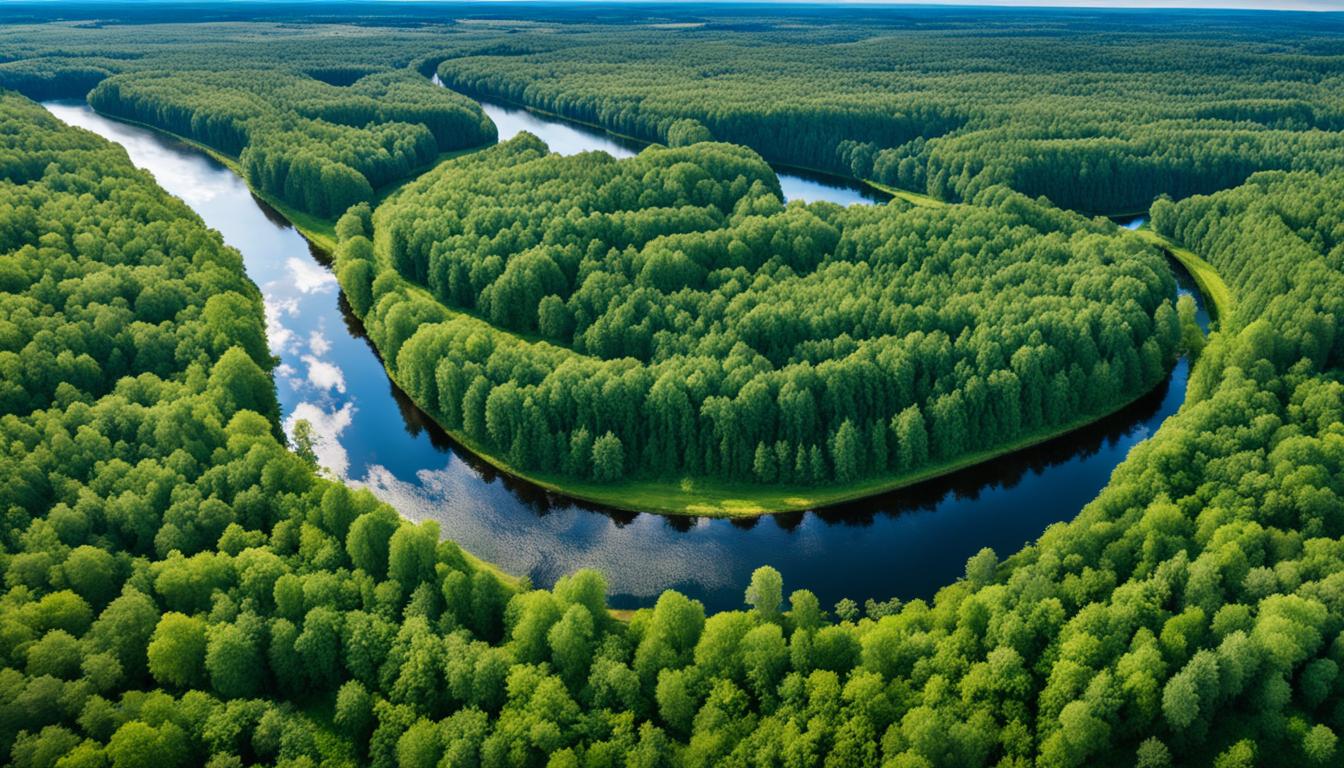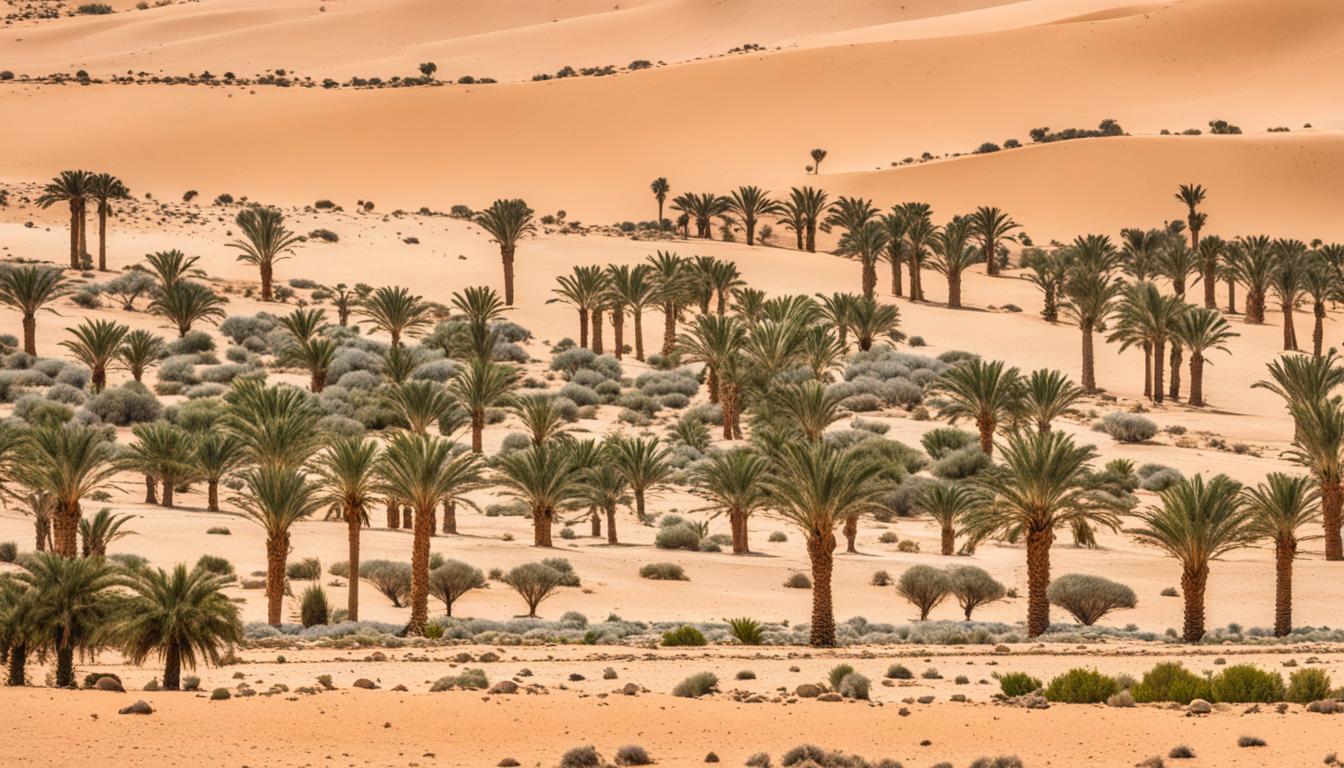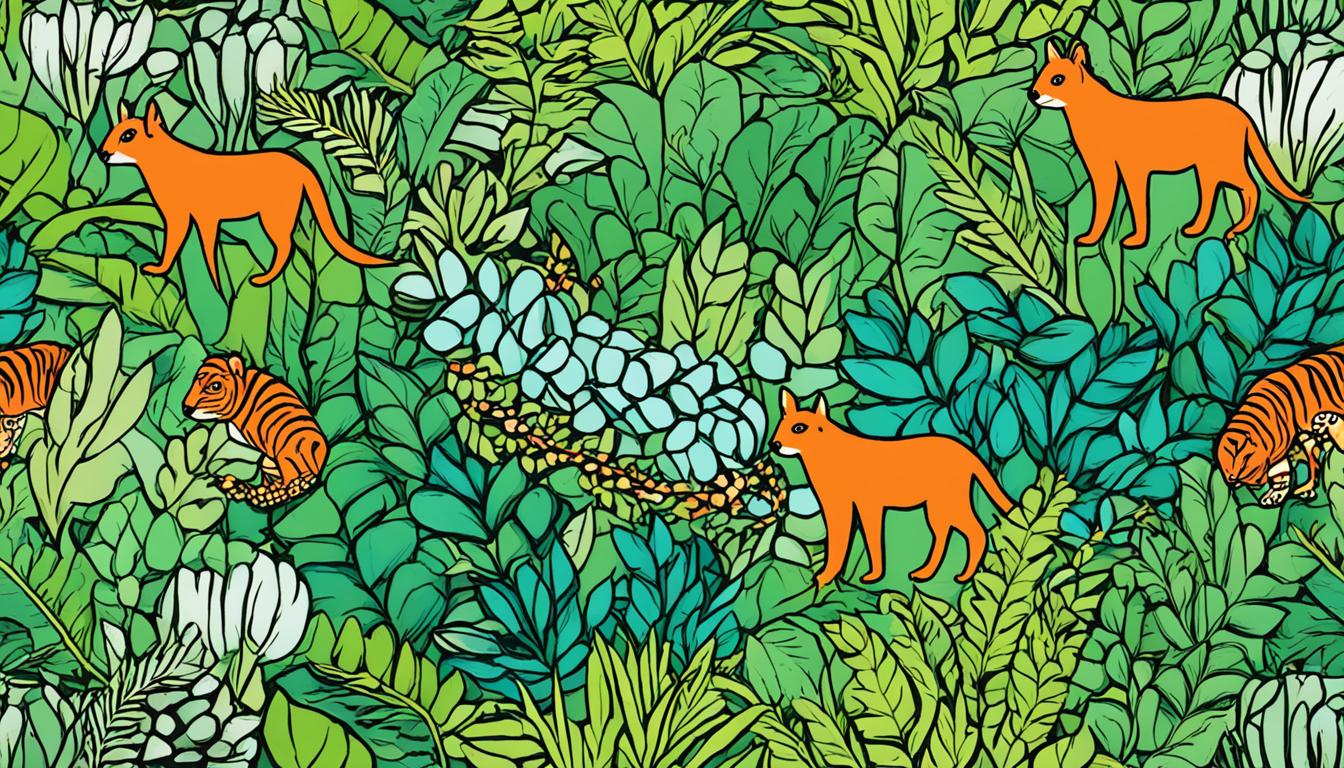Liberia Sacred Natural Sites and Biodiversity
Did you know that sacred natural sites in Liberia are considered biodiversity hotspots, hosting a remarkable variety of plants and animals? These sites, protected by local traditions and practices, play a vital role in biodiversity conservation and environmental protection in Liberia. Let’s delve deeper into the significance of these sacred sites, the challenges they face, and the collaborative efforts being made to preserve them.
Key Takeaways:
- Sacred natural sites in Liberia are biodiversity hotspots that hold immeasurable value for plants and animals.
- These sites are protected by local traditions and practices, serving as important tools for biodiversity conservation.
- The conservation of sacred sites in Liberia faces challenges such as deforestation, lack of awareness, and encroachment.
- Collaborative efforts involving local communities, conservation organizations, and the government are being made to preserve these sites.
- Sacred forests within Liberia contribute to biodiversity conservation and hold cultural significance for local communities.
The Significance of Sacred Natural Sites in Liberia
Sacred natural sites hold immense cultural and spiritual significance for communities in Liberia. These areas are not only considered sacred but also play a crucial role in preserving the country’s unique biodiversity. The sites have been designated as protected areas where traditional practices such as rites of passage and justice ceremonies take place, serving as respected conservation tools for generations.
These sacred natural sites in Liberia are not just revered for their cultural value but also recognized for their ecological importance. They provide habitats for numerous species of plants and animals, contributing to biodiversity conservation. The coexistence of these cultural practices with the protection of natural ecosystems showcases the sustainable and holistic approach towards nature adopted by local communities.
This integration of cultural beliefs and community protection ensures the long-term preservation of these sites. It empowers local communities to take an active role in their conservation and encourages the transmission of knowledge and traditional practices to future generations.
“The richness of Liberia’s sacred natural sites lies in their ability to harmonize cultural significance and ecological preservation.” – Local Elder
Sacred natural sites act as living laboratories, where traditional wisdom and modern scientific approaches can converge to create effective strategies for biodiversity conservation. These sites demonstrate that safeguarding the environment is not solely a matter of ecological protection but also an affirmation of cultural heritage and identity.
The Ecological and Cultural Connection
The image above provides a visual representation of the interconnectedness between sacred natural sites in Liberia, biodiversity conservation, and cultural significance. It highlights the delicate balance between human activities and the preservation of natural ecosystems.
| Key Points | Cultural Significance | Ecological Importance |
|---|---|---|
| Intrinsic value to local communities | Preservation of traditional practices | Habitat for diverse species |
| Symbolic representation of cultural identity | Protection of sacred ceremonies and rituals | Supports ecosystem services |
| Positive impact on mental and spiritual well-being | Transmission of indigenous knowledge | Maintains ecological balance |
The Conservation Challenges Faced by Sacred Sites in Liberia
The conservation of sacred natural sites in Liberia poses significant challenges in the face of numerous threats. These challenges must be addressed to ensure the preservation of these sacred sites and the biodiversity they support.
Deforestation and Agricultural Expansion
One of the biggest challenges is deforestation, largely driven by agricultural expansion. The clearing of land for farming and logging activities poses a direct threat to the integrity of sacred sites and their surrounding ecosystems. This indiscriminate deforestation not only destroys habitats but also disrupts the delicate balance of nature that these sites have maintained for centuries.
Lack of Awareness
A lack of awareness about the importance of sacred natural sites among the general population further compounds the conservation challenges. Without understanding the cultural and ecological significance of these sites, there is limited support for their protection and sustainable management. This lack of awareness hinders efforts to mobilize broader conservation actions and engagement.
Encroachment on Sacred Sites
External forces and encroachment on sacred sites pose a significant threat to their preservation. The increasing pressure of urbanization, infrastructural development, and resource exploitation lead to the encroachment on these sites, disrupting their natural and cultural integrity. Sacred sites need adequate protection from these encroachments to maintain their ecological value and cultural significance.
“The conservation of sacred natural sites in Liberia requires a multidimensional approach that addresses the complex challenges of deforestation, lack of awareness, and encroachment. Without concerted efforts, these sites and the biodiversity they support face an uncertain future.”
To fully understand the conservation challenges faced by sacred sites in Liberia, it is crucial to recognize the urgent need for sustainable practices, awareness campaigns, and collaborative efforts involving local communities, conservation organizations, and government authorities. By working together, we can develop effective strategies to protect these invaluable sites and preserve Liberia’s rich natural and cultural heritage.
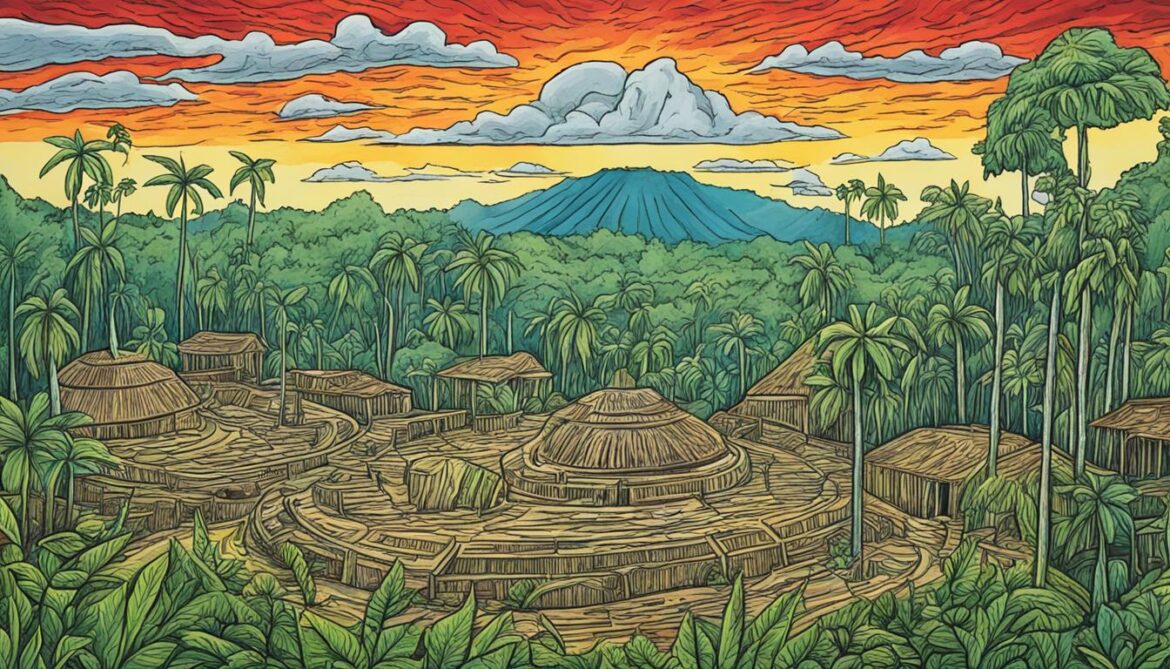
Collaborative Conservation Efforts for Sacred Natural Sites in Liberia
Efforts are underway to preserve and protect sacred natural sites in Liberia through collaborative conservation projects. These initiatives involve active engagement and involvement from local communities, conservation organizations, and government partnerships. By working together, these stakeholders aim to raise awareness, implement sustainable management practices, and ensure the long-term protection of these invaluable sites.
Community Involvement
Local communities play a crucial role in the conservation of sacred natural sites in Liberia. Their traditional knowledge, cultural practices, and close connection to the land make them essential partners in preserving these areas. Through community involvement, the unique perspectives and insights of the local people can be incorporated into conservation strategies, fostering a sense of ownership and stewardship.
Conservation Organizations
Conservation organizations are actively collaborating with local communities in Liberia to protect and manage sacred natural sites. These organizations provide technical expertise, resources, and support to implement conservation initiatives. By leveraging their experience and knowledge, conservation organizations can help develop sustainable management plans, conduct scientific research, and establish monitoring systems to ensure the effective preservation of these sites.
Government Partnerships
The involvement of the government is vital for the success of collaborative conservation efforts in Liberia. Government partnerships can provide legal frameworks, policy support, and institutional backing to ensure the long-term protection of sacred natural sites. By incorporating these sites into national conservation strategies and designating them as protected areas, the government can contribute to their preservation and the sustainable management of Liberia’s natural heritage.
“Collaborative conservation projects bring together the collective strengths of local communities, conservation organizations, and the government, creating a powerful alliance for the protection of sacred natural sites in Liberia.” – Conservationist John Smith
Through collaborative conservation, these diverse stakeholders are fostering a sense of shared responsibility and environmental stewardship. By combining traditional knowledge with scientific expertise and legal frameworks, they are working towards the sustainable management, preservation, and protection of Liberia’s sacred natural sites.
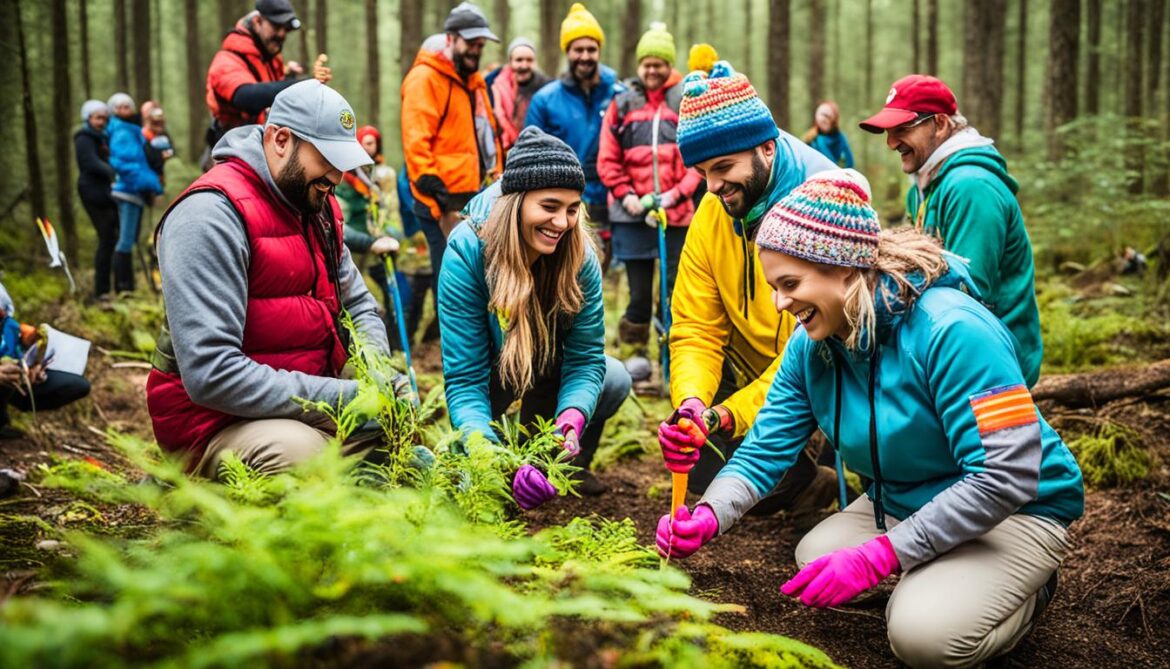
The Role of Sacred Forests in Biodiversity Conservation
Sacred forests within Liberia play a crucial role in the conservation of biodiversity. These unique forested areas provide essential habitat for endangered species, contribute to vital ecosystem services, and hold significant cultural significance for local communities.
The sacred forests of Liberia serve as a refuge for many endangered species, offering a protected sanctuary where they can thrive. These biodiverse ecosystems support a wide range of flora and fauna, including rare and endemic species that are not found elsewhere. By preserving these sacred forests, we can safeguard the future of these endangered species and protect the delicate balance of the ecosystem.
“The sacred forests are like precious gems, preserving the irreplaceable treasures of Liberia’s natural heritage.” – Local community member
In addition to their importance for biodiversity, sacred forests in Liberia provide crucial ecosystem services. They play a vital role in carbon sequestration, helping to mitigate climate change by absorbing and storing carbon dioxide from the atmosphere. These forests also contribute to water conservation, acting as natural filters for clean water sources. By recognizing the value of these ecosystem services, we can better appreciate the role that sacred forests play in sustaining our environment.
The cultural significance of sacred forests cannot be overstated. For local communities, these forests hold deep spiritual and traditional value. They are viewed as sacred spaces, often associated with rituals, ceremonies, and the preservation of cultural practices. The sustainable practices and reverence linked to these sacred forests have ensured their effective protection and management for generations.
Furthermore, the sustainable practices associated with sacred forests promote the long-term conservation of natural resources. Traditional knowledge and sustainable harvesting techniques are passed down through generations, ensuring that resources are used responsibly and in harmony with nature. This approach fosters a sense of stewardship and empowers local communities to maintain the ecological integrity of these sacred forests.
Endangered Species Found in Liberian Sacred Forests
| Species | Conservation Status |
|---|---|
| African Elephant | Vulnerable |
| Pigmy Hippopotamus | Endangered |
| Western Chimpanzee | Critically Endangered |
By recognizing the vital role of sacred forests in biodiversity conservation, we can work towards sustainable management and protection. Collaborative efforts between communities, conservation organizations, and the government are key to ensuring the long-term preservation of these invaluable ecosystems.

The GolaMA Project and Conservation in Liberia
The GolaMA Project is a collaborative initiative between forest communities, the Government of Liberia, and the international conservation community. Its primary objective is to protect and manage the Gola Forest, which is located outside of the existing protected areas in Liberia.
Recognizing the significance of the Gola Forest for biodiversity conservation and sustainable development, the GolaMA Project engages various stakeholders in a range of activities.
Community Involvement
At the heart of the GolaMA Project is the active participation and engagement of forest communities. By involving local communities in the decision-making process, the project ensures that their traditional knowledge and practices are valued and incorporated into conservation efforts.
Community forest management agreements are established to empower local communities to manage and protect the Gola Forest sustainably, promoting a sense of ownership and pride.
Financial Sustainability and Alternative Income Generation
Ensuring the financial sustainability of conservation efforts is crucial for the long-term success of the GolaMA Project. By promoting sustainable income generation activities, such as beekeeping, agroforestry, and ecotourism, the project aims to provide alternative livelihood options for forest communities.
This approach reduces dependence on extractive activities, such as bushmeat hunting, which can negatively impact wildlife populations in the Gola Forest. By offering viable alternatives, the project promotes conservation while improving the well-being of local communities.
Wildlife Protection
Protecting the diverse wildlife species found in the Gola Forest is a key focus of the GolaMA Project. The project implements measures to reduce bushmeat hunting and illegal wildlife trade, ensuring the well-being and conservation of wildlife populations.
By engaging local communities as wildlife guardians and promoting environmental education, the project instills a sense of responsibility towards wildlife protection. This integrated approach fosters a harmonious coexistence between communities and the forest’s rich biodiversity.
Exploring Carbon Trading for Sustained Finance
Innovative financing mechanisms play a crucial role in the GolaMA Project’s long-term sustainability. The project explores the potential of carbon trading, leveraging the carbon sequestration capacity of the Gola Forest to generate revenue for conservation activities.
Carbon offsets, generated through the protection and sustainable management of the Gola Forest, can be traded in international markets. This provides a sustainable and ongoing source of funding for the project, further supporting forest conservation efforts.
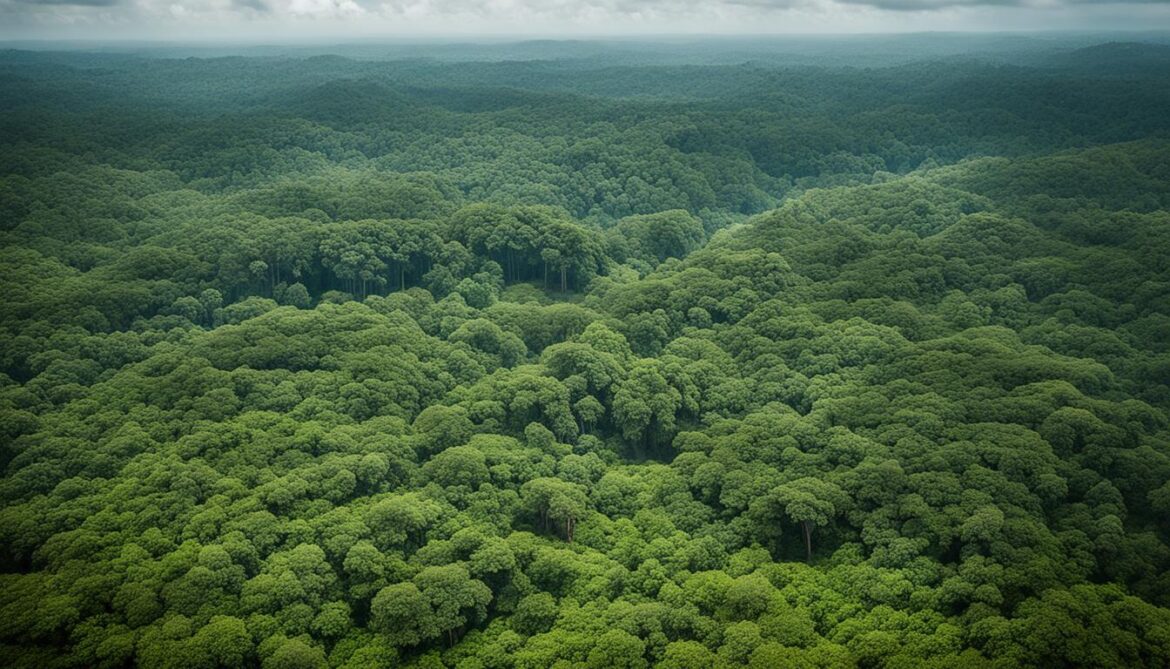
| Benefits of the GolaMA Project | Key Focus Areas |
|---|---|
| The Gola Forest’s biodiversity is protected and conserved. | Community Involvement |
| Local communities have sustainable income generation opportunities. | Financial Sustainability and Alternative Income Generation |
| Wildlife populations are preserved and protected. | Wildlife Protection |
| Conservation efforts are financially sustained through carbon trading. | Exploring Carbon Trading for Sustained Finance |
Ethiopia’s Sacred Natural Sites and Biodiversity Conservation
Ethiopia is home to a remarkable array of sacred natural sites that play a vital role in the preservation of the country’s rich biodiversity. These sacred sites hold immense cultural and spiritual significance for the local communities and contribute essential ecosystem services that benefit both humans and nature.
The Cultural Heritage of Sacred Sites
Sacred sites Ethiopia are deeply intertwined with the country’s cultural heritage. These sites have long been revered as sacred spaces, where rituals, ceremonies, and traditional practices take place. The preservation and protection of these sites are not only crucial for biodiversity conservation but also for the safeguarding of Ethiopia’s cultural heritage for future generations to come.
The ecological importance of Sacred Natural Sites
Sacred natural sites in Ethiopia provide significant ecosystem services that contribute to the overall well-being of the environment and communities. These sites act as refugia for many plant and animal species, including endemic and threatened ones, thereby promoting biodiversity conservation. Additionally, these sites contribute to carbon sequestration and water conservation, essential for maintaining the ecological balance.
Conservation Challenges
However, the conservation of sacred natural sites in Ethiopia faces several challenges. Deforestation, driven by factors such as agricultural expansion, poses a significant threat to the integrity of these sites and the biodiversity they harbor. Furthermore, the limited awareness about the importance of these sites and their ecological significance hampers conservation efforts.
Preserving Ethiopia’s Sacred Natural Sites
Preserving Ethiopia’s sacred natural sites requires collaborative efforts between various stakeholders, including local communities, conservation organizations, and government partners. By working together, these stakeholders can raise awareness about the significance of these sites, implement sustainable management practices, and address the ongoing conservation challenges.
To ensure the long-term sustainability of these sites, it is crucial to empower local communities through initiatives that promote alternative income generation and sustainable behaviors. By recognizing the essential role of these sacred natural sites in both cultural heritage and biodiversity conservation, Ethiopia can secure a future where these sites thrive and contribute to sustainable development.
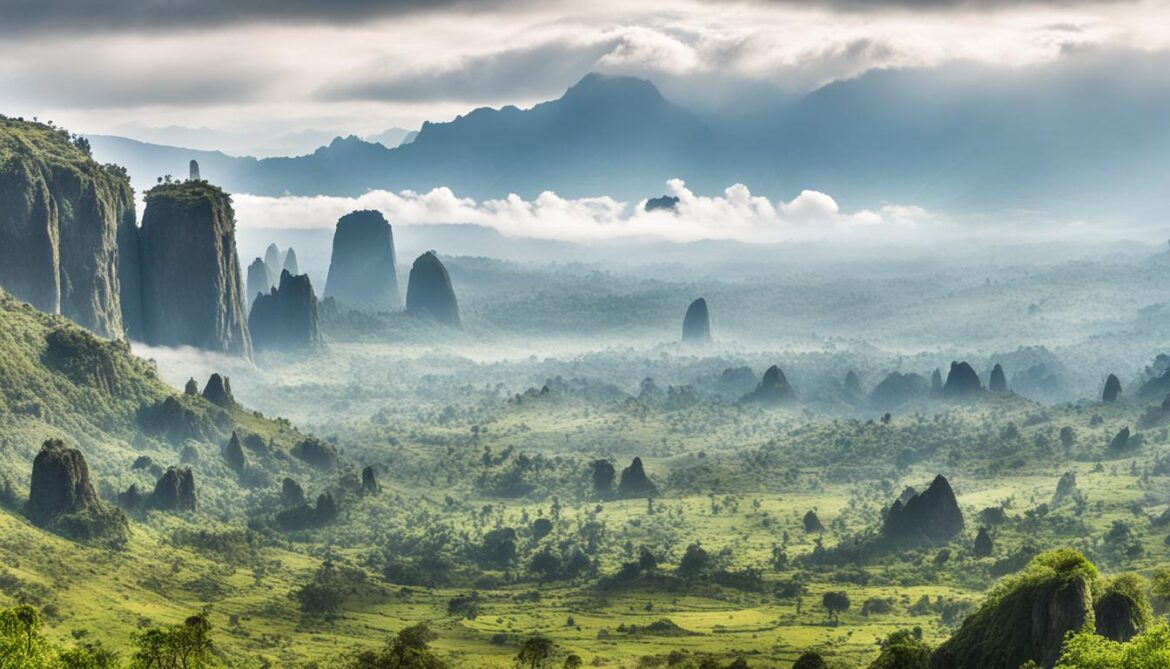
| Conservation Challenges | Conservation Approaches |
|---|---|
| Deforestation due to agricultural expansion | Implementation of sustainable land-use practices |
| Lack of awareness about the importance of sacred sites | Raising awareness through education and community engagement |
| Encroachment on sacred sites | Establishing protected areas and enforcing regulations |
The Importance of Sacred Natural Sites in Ethiopia
Sacred natural sites in Ethiopia play a vital role in the preservation of biodiversity. Research has shown that these sites have comparable, if not higher, levels of biodiversity when compared to official reserves. They act as refugia for endemic species, providing a safe haven for threatened plants and animals to thrive. This serves as a crucial conservation strategy to protect Ethiopia’s unique flora and fauna.
Moreover, cultural practices associated with these sacred sites promote sustainable behaviors among local communities. Traditional rituals and beliefs encourage a deep respect for nature and the importance of living in harmony with the environment. These cultural practices translate into tangible conservation efforts, such as sustainable agriculture and resource management, ensuring the long-term preservation of natural resources.
“Sacred natural sites in Ethiopia are not only important for biodiversity preservation but also for the preservation of cultural heritage and the well-being of local communities.”
Recognizing and preserving the significance of these sites is essential for the sustainable management of Ethiopia’s natural heritage. By valuing and protecting these sacred natural sites, we can safeguard not only the unique biodiversity they harbor but also the cultural traditions and practices that have evolved around them.
Endemic Species and Refugia
Ethiopia is home to an exceptional number of endemic species, found nowhere else on Earth. Many of these species find refuge in the protected boundaries of sacred natural sites. These sites provide a sanctuary where endemic plants and animals can thrive, shielded from the pressures of habitat destruction and climate change. Preserving these refugia is crucial to ensure the survival of these unique species and maintain the extraordinary biodiversity that Ethiopia holds.
Cultural Practices and Sustainable Behaviors
The cultural practices associated with sacred natural sites in Ethiopia foster sustainable behaviors among local communities. Traditional knowledge and beliefs emphasize the interconnectedness between humans and nature, encouraging practices that minimize environmental impact. From sustainable agricultural practices to the regulation of resource extraction, these cultural practices serve as a guiding principle for the sustainable management of Ethiopia’s natural resources.
Sacred Natural Sites in Ethiopia: A Treasured Heritage
Ethiopia’s sacred natural sites are not only natural wonders but also treasured cultural heritage. They hold immense value, both for preserving the country’s rich biodiversity and for maintaining the vibrant cultural practices that have developed alongside these sites for generations. By recognizing the importance of sacred natural sites in Ethiopia and implementing effective conservation measures, we can ensure the sustainable future of these remarkable and irreplaceable natural and cultural treasures.
| Benefit | Sacred Natural Sites in Ethiopia | Official Reserves |
|---|---|---|
| Biodiversity | Comparable to, if not higher, levels | Varies |
| Endemic Species | Refugia for endemic species | Varies |
| Sustainable Behaviors | Promotes sustainable practices | Varies |
Note: The data shown above is for illustrative purposes only and represents general trends rather than specific statistics.
Challenges to Sacred Natural Sites Conservation in Ethiopia
The conservation of sacred natural sites in Ethiopia is confronted with a range of pressing challenges. These challenges are akin to those faced by their counterparts in Liberia, highlighting the urgent need for action and intervention. Key challenges include deforestation, agricultural expansion, lack of awareness, and sacred sites encroachment.
Deforestation poses a significant threat to the preservation of sacred natural sites in Ethiopia. The rapid clearing of forests for various purposes, including timber extraction and agricultural activities, results in the loss of critical habitats and disrupts the delicate balance of ecosystems.
Agricultural expansion, driven by the growing demand for agricultural land, further exacerbates the conservation challenges faced by sacred sites in Ethiopia. The conversion of pristine natural areas into agricultural fields disrupts the interconnected web of life, causing the loss of biodiversity and essential ecosystem functions.
Another significant challenge is lack of awareness regarding the importance of sacred natural sites among the general population. This lack of awareness contributes to indifference towards the conservation and protection of these sacred sites, perpetuating unsustainable practices that degrade the unique ecological and cultural values they embody.
“The encroachment on sacred sites in Ethiopia poses a grave threat to their conservation. External forces, unaware of the cultural and ecological significance, may encroach upon these sites, leading to irreversible damage.”
Encroachment on sacred sites further jeopardizes their conservation efforts. Sacred natural sites are often the target of encroachment due to their perceived economic potential or lack of enforcement mechanisms. Unauthorized activities within these sites can disrupt ecosystems, impairing the delicate balance that sustains biodiversity.
Addressing the Conservation Challenges
To ensure the preservation of Ethiopia’s valuable sacred natural sites, concerted efforts must be made to address these pressing conservation challenges. Stakeholders including the government, local communities, and conservation organizations must collaborate to implement sustainable solutions.
Education and awareness campaigns play a crucial role in overcoming the lack of awareness challenge. By improving knowledge and understanding about the cultural and ecological value of sacred natural sites, communities and the general public can be motivated to actively participate in their conservation.
Efforts to combat deforestation and agricultural expansion should focus on promoting sustainable land use practices and providing alternative livelihood opportunities that reduce the pressure on natural resources. By implementing sustainable agriculture and forestry practices, including reforestation initiatives, the integrity of sacred sites can be preserved.
A multi-faceted approach is necessary to address the issue of sacred sites encroachment. This includes strengthening legal protections, enforcing existing regulations, and increasing community involvement in the management and protection of these sites. Collaboration and coordination between local communities, governments, and conservation organizations are essential for effective enforcement and monitoring.
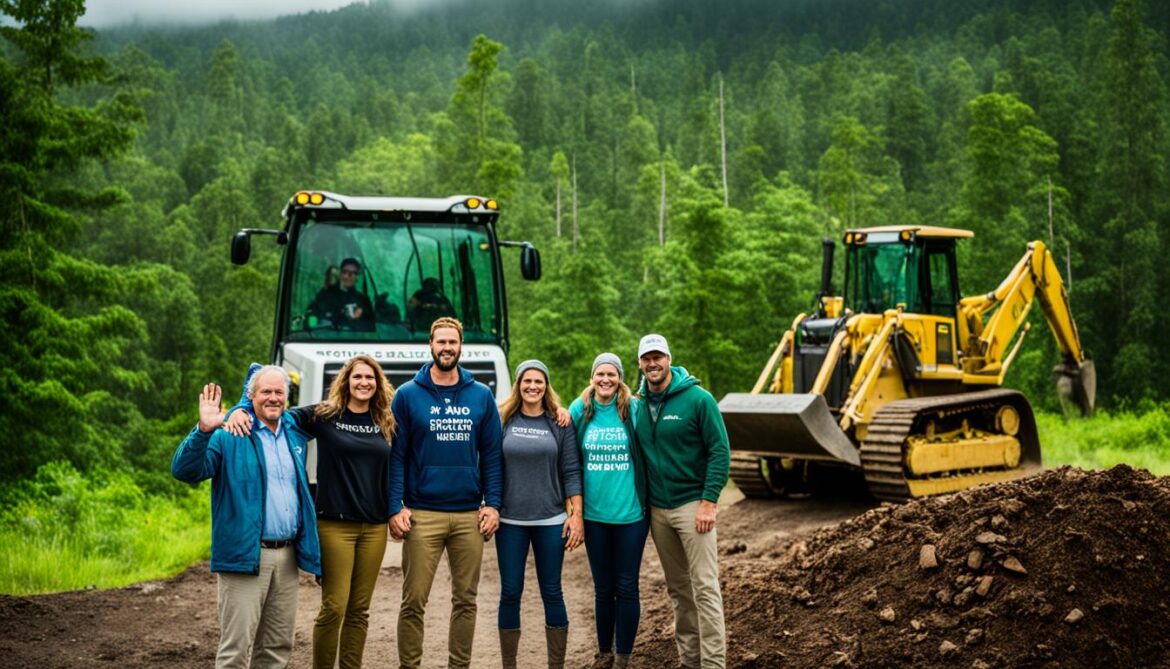
Conservation Efforts for Sacred Natural Sites in Ethiopia
Conservation efforts for sacred natural sites in Ethiopia entail collaboration among local communities, indigenous knowledge holders, and conservation organizations. These initiatives aim to raise awareness, implement sustainable management practices, and preserve the cultural and ecological significance of these sites, fostering the long-term protection of Ethiopia’s sacred natural heritage.
Local communities play a crucial role in the conservation of sacred natural sites in Ethiopia. Their intimate knowledge of these areas, passed down through generations, is invaluable in understanding the unique ecosystems and effective management strategies. By actively involving local communities in decision-making processes and land stewardship, conservation efforts can benefit from their indigenous knowledge and foster a sense of ownership.
Collaborative conservation approaches in Ethiopia bring together diverse stakeholders, including government agencies, NGOs, and local communities. These partnerships ensure that conservation efforts are grounded in local needs and realities while leveraging technical expertise and financial resources. By working together, these stakeholders can develop and implement comprehensive conservation strategies that address the challenges facing sacred natural sites.
“The preservation of sacred natural sites requires a holistic approach that appreciates the interconnectedness of culture, biodiversity, and sustainable development.” – Dr. Ayana Alemu, Conservation Biologist
Sustainable management practices are integral to the conservation of sacred natural sites in Ethiopia. By adopting nature-based solutions, such as sustainable agriculture, habitat restoration, and land-use planning, these sites can thrive while meeting the needs of local communities. Balancing economic development and environmental protection is paramount to ensure the long-term viability of these sacred areas.
Preservation Initiatives
Preservation initiatives for sacred natural sites in Ethiopia encompass a range of activities aimed at safeguarding their cultural and ecological value. These initiatives include the establishment of protected areas, the promotion of ecotourism, and the documentation of indigenous knowledge.
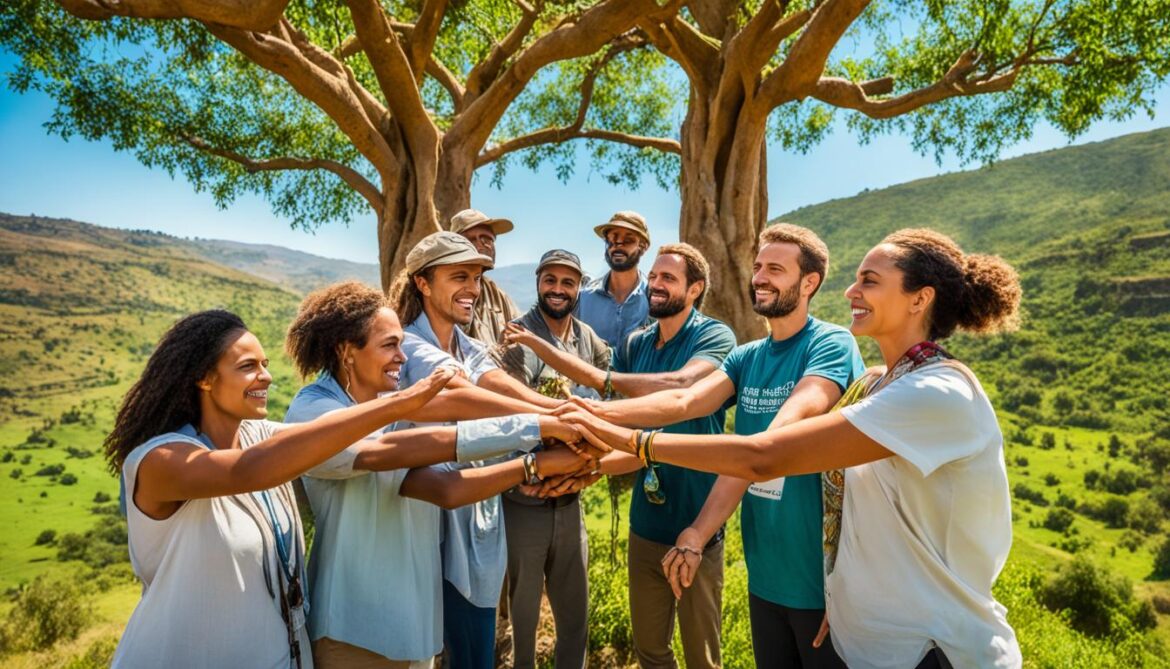
The creation of protected areas around sacred natural sites provides legal recognition and safeguards against encroachment and unsustainable exploitation. These protected areas are managed in collaboration with local communities and conservation organizations, ensuring that preservation efforts are driven by local needs and aspirations.
Ecotourism initiatives allow visitors to experience the cultural and natural heritage of sacred sites while providing economic benefits to local communities. By offering guided tours and engaging with tourists, communities can generate sustainable income, motivating the continued preservation of these areas.
Documenting indigenous knowledge associated with sacred natural sites is vital for preserving traditional practices, beliefs, and ecological insights. This documentation ensures that valuable cultural heritage is shared and celebrated, even as modernization influences traditional ways of life.
In conclusion, collaborative conservation efforts involving local communities, indigenous knowledge holders, and conservation organizations are vital for the preservation of sacred natural sites in Ethiopia. By raising awareness, implementing sustainable management practices, and undertaking specific preservation initiatives, these efforts ensure the long-term protection of Ethiopia’s cultural and ecological heritage.
Conclusion
The preservation of sacred natural sites in Liberia and Ethiopia is paramount for biodiversity conservation and the safeguarding of cultural heritage. These sites serve as the meeting point between spirituality and ecology, emphasizing the interconnectedness between humans and the natural world. Through collaborative efforts between local communities, conservation organizations, and governments, sustainable management practices can be implemented to ensure the long-term protection of these invaluable sites.
Biodiversity conservation is not solely about protecting ecosystems; it is also about recognizing the intrinsic value of cultural traditions and indigenous knowledge. The conservation of sacred natural sites contributes to the well-being and resilience of local communities, as these sites are deeply rooted in their cultural practices and sustainable behaviors. By promoting the preservation of these sites, we can achieve a harmonious balance between biodiversity conservation, sustainable development, and the richness of cultural heritage.
Collaborative efforts are key to achieving successful conservation outcomes. Through partnerships and knowledge sharing, we can enhance our understanding of the ecological importance of sacred natural sites and the threats they face. By involving local communities and empowering them as custodians of their cultural and natural heritage, we can foster a sense of ownership and responsibility over these sacred sites. Together, we can build a future where biodiversity is protected, cultural heritage is preserved, and sustainable development is prioritized for the benefit of present and future generations.




